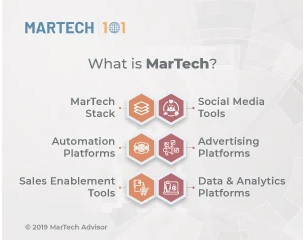
How to Optimize for Circle to Search
Google has always been serious about being curious. Now, the company has a new way to find the perfect answer to your searches — Circle

If you’ve been in digital marketing for any length of time, you’ve probably heard the word “martech.” But what does it mean?
It’s a portmanteau. But what does that mean?
A portmanteau is a word that’s made from the sounds of two other words. In this case, the words “marketing” and “technology” combine to make the word “martech.”
So martech is marketing technology. It’s that simple.
In this guide, I’ll take a deep dive into the concept of martech and how you can use it to land more sales.
So how, exactly, does martech enable you to grow your business? Depending on the toolset you select, it can:
And more. In short, martech does what business technology is supposed to do: it makes your life easier, increases operational efficiencies, and boosts your bottom line.

If you want to play with a martech tool, you can often do that without installing anything on your PC.
Why? Because many martech tools run in the cloud.
Our high-tech friends often refer to cloud-based applications as “Software as a Service” or SaaS for short.
Usually, you can access a SaaS tool from the convenience of your own web browser. Just go to a site like SEMRush today and get the ball rolling. In fact, you can get started for free.
Even better: many martech tools also offer application programming interfaces or APIs. Your development team can use those APIs to grab important data from your tools, aggregate that data, and use it to improve your online marketing.
Be prepared, though: API access usually costs extra money.
Martech tools generally fall into one of two categories: Swiss army knives and can openers.
A Swiss army knife martech tool does “everything.”
Note the quotation marks in that last sentence. Of course, the tool doesn’t do everything. But it’s a comprehensive suite of tools that handles various digital marketing tasks., such as SEO, keyword research, rank tracking, on-site optimization, and content marketing.
The aforementioned SEMRush is a classic Swiss army knife martech tool. As is Ahrefs.
Can opener tools focus on a single aspect of digital marketing? OptinMonster, for example, will help you build your email distribution list. And that’s all it will do.
Strategists often start with Swiss army knife tools so they can handle many of their responsibilities from a single interface.
If there’s something lacking in the Swiss army knife tool, they’ll find a can opener that handles that task and use it.
When you say “martech,” you haven’t said everything. It consists of several categories.
In the next sections, I’ll cover each of those categories in detail.
Keep in mind, though: some tools handle more than one category (Swiss army knife tools) while other tools only work within a single category (can opener tools).
Also: there are several competing tools within each category. So do your due diligence before deciding which application you’d like to use in your digital strategy.
It’s been said that content is king. While some may dispute that, there’s no doubt that a great content strategy can bring prospects to your website.
So wouldn’t it be great if you could use a tool to help you get them there? Fortunately, there are plenty of options to choose from.

Start with a good content management system (CMS). Right now, the undisputed king of all CMS tools is WordPress. That’s probably where you should begin, but feel free to check out Adobe Experience Manager, Joomla and Drupal as well.
Next up for content: search engine optimization (SEO). That’s the task of optimizing your website so it gets a good rank in Google, Bing, and other search engines.
Take a look at Moz and Majestic if you need some help in that space. Also, if you’re using WordPress, don’t forget to install the Yoast SEO plugin. That’s a must-have.
Of course, you’ll also need to create content that brings visitors to your site. And if you don’t have the time or the imagination to write fresh content regularly, you’ll need a crutch (or two).
Take a look at BuzzSumo if you’d like some inspiration. If you need more than just inspiration, go with Contently.
The web has certainly evolved since the early 1990s. Back then, many folks were using browsers like Lynx to view text-only content.
Nowadays, we can watch whole movies with a tablet.
Those kinds of advances benefit digital marketers as well. You can use high-quality photos and videos to promote your brand.
And you should.
Fortunately, plenty of tools exist to help you get the most out of the Internet in your online strategies.
First up is the Adobe Creative Cloud.
The name is a bit of a misnomer, though. Not all the tools run in the cloud.
Still, the tools that you get with Adobe CC are well worth the money. Even if you have to install them.
You’ve probably already heard about the most famous tool in the set: it’s called Photoshop.
Yep, that Photoshop. You can use it to create absolutely spectacular imagery for your web campaigns. It will also work for old-school, on-paper marketing.
There’s also a couple of video tools included with the license: Premiere Pro and After Effects. Between those two applications, you can create a snazzy, stylish, and irresistible marketing promo.
Adobe CC offers several other tools as well: InDesign for elegant layouts, Illustrator for vector art creations, XD for user experiences, and more.
While Adobe gives you significant power in your marketing efforts, never forget the phrase that with great power comes great responsibility.
In this case, that means the learning curve for Adobe tools is approximately the size of the St. Louis Arch.
If you’re looking for speedier solutions, check out Biteable, Wistia, and Canva.
And let’s not forget that rich media consists of more than just visuals. You might use podcasts to promote your brand as well.
To that end, look at tools like Buzzsprout, Audacity, Ringr, and Logic Pro,
It was very nice of people like Mark Zuckerberg and Jack Dorsey to give you free platforms to promote your brand. Hopefully, you’re using them.
You might need a few tools to help you with social media marketing, though.
For starters, wouldn’t it be nice to view several of your social media platforms with one user interface? You can do that with solutions like Hootsuite and Sprout Social.
Those tools can also help with scheduling social media posts. As can Buffer.
If you’d like to monitor how people talk about your brand online, then have a look at Brandwatch.
And if you’re interested in reaching out to some influencers who can promote your products to their massive social media audiences, check out Upfluence.
Thanks to martech, you and your team members can save countless hours on day-to-day marketing tasks.
Marketing automation lives up to its name. It handles the responsibilities that take your precious time away from more important tasks, like building your business.
Marketo is probably a good place to begin if you’re looking for a robust automation solution.
Keep in mind, though, Marketo is now owned by Adobe. And, like most Adobe products, it ain’t cheap.
However, you do get a lot of automation for the money you spend. But if you’re bootstrapping as a startup, Marketo probably isn’t the best option.
So what is the best option? That depends on what you’re trying to automate, exactly.
The Freshworks team offers solutions that start at just a few dollars per month. As a bonus, you get to test-drive them for free.
If you have a little more money to throw around, you can get into Customer.io for about $150 per month.
Finally, if you’re in the market for mobile-first marketing automation solutions, check out Swrve and CleverTap.
You might offer a great product or service, but if nobody knows about it, how will you sell it? The answer is advertising.
Fortunately, there are plenty of platforms online to help you promote your business with paid ads.
Start with Google Ads and Microsoft Advertising. They both give you plenty of ways to reach people in your target market.
With Google Ads, for example, you can run ads that show up in search results based on the keywords that people type in to the search bar. Google Ads also lets you run display ads on websites.
And both of those options enable you to target your advertising to people who will take an interest in what you’re selling. Even better: you only pay when they click your ad.
But you shouldn’t confine your ads to just search and websites. You can run ads on social media as well.
Many of the major platforms at this point not only empower you to create and launch your own campaigns, they also enable you to target your ads based on interests and demographics.
But you’re going to need more than just a place to advertise. You need tools to optimize and streamline your campaigns as well.
Take a look at AdEspresso by Hootsuite. You can use it to run your Facebook, Instagram, and Google Ads campaigns from a single place.
Also, take some to review Qwaya and StitcherAds for Facebook/Instagram marketing.
You might also want to run some native ads. Those are ads that look like they’re part of the content on a website but they’re really just ads that link out to another site.
Taboola and Outbrain (now the same company) are great places to begin if you’re looking to promote your business with native ads.
If you’d like to combine your online campaigns with marketing automation, then you should look at a programmatic advertising solution. A great programmatic tool will help you target your ads with laser-like precision and gain access to inventories at just the right moments.
Check out SmartyAds and Simpli.fi if you’d like to consider programmatic advertising alternatives.
If you’re running a business where you need to sell products with the assistance of sales reps, then you’re going to need a CRM.
What’s a CRM? It’s a Contact Relationship Management tool. Your reps will use it to find and develop new leads. They’ll also use the CRM to help close sales.
The undisputed Rolls Royce of CRM platforms is Salesforce.
But there are many components in Salesforce, some of them more valuable to your organization than others.
If you’re just getting started, you’ll probably want to get the ball rolling with the Salesforce Sales Cloud. That will set you back $25 per month.
Not bad for a Rolls Royce solution. But keep in mind, you will be tempted to pay for other Salesforce products.
If you can handle going with a Nissan Sentra instead of a Rolls Royce solution, take a look at Freshworks, Zoho, or Prospect.io.
What good are all these marketing tools if you can’t check how well they’re performing for you?
Fortunately, most of them offer in-house analytics that you can use to monitor progress. Unfortunately, that’s not always good enough.
You see, if you’re using one or more can opener tools to handle marketing, then you’ll need to collect and analyze data from all those tools.
Fortunately, other tools exist to help you do just that.
Have a look at Adobe Audience Manager for starters. It’s an expensive solution, but it unsurprisingly plays nicely with the Adobe Experience Manager if you’re using that as your CMS of choice.
Another expensive solution is Salesforce DMP. As the name implies, it’s an ideal option if you’re using the Salesforce suite of products for sales and marketing.
Other platforms in this space include Lotame and Oracle DMP.
Well, there you have it: a primer on martech.
It’s a lot to take in all at once. If you’re looking for an action item to take away from this guide, think about the nature of your business and which martech category you believe works best for your brand.
Then, start evaluating products in that category and pick one that works.
After that, move on to another category.
Welcome to John Lincoln’s personal website. On this website, we offer courses by John Lincoln, review software, publish articles and videos. You can also learn about John Lincoln’s books, films, book him to speak and contact him. John is directly associated with many of the businesses mentioned on this website and freely discloses this information.

John Lincoln is CEO of Ignite Visibility, one of the top digital marketing agencies in the nation. Ignite Visibility is a 4x Inc. 5,000 company. Ignite Visibility offers a unique digital marketing program tied directly to ROI with a focus on using SEO, social media, paid media, CRO, email, Amazon and PR to achieve results. Outside of Ignite Visibility, Lincoln is a frequent speaker and author of the books “Digital Influencer” and “The Forecaster Method.” Lincoln is consistently named one of the top digital marketers in the industry and was the recipient of the coveted Search Engine Land “Search Marketer of The Year” award. Lincoln has taught digital marketing and Web Analytics at the University of California San Diego since 2010, has been named as one of San Diego’s most admired CEO’s and a top business leader under 40. Lincoln has also made “SEO: The Movie” and “Social Media Marketing: The Movie.” His business mission is to help others through digital marketing.
Want to get in touch with John Lincoln? Click Here To Reach Out.

Google has always been serious about being curious. Now, the company has a new way to find the perfect answer to your searches — Circle

The concept of keyword cannibalization has evolved over the last few years because of Google updates and its preferences for ranking. It’s an SEO challenge

If you’re asking yourself, “How do I identify competitive keywords?” you’ve come to the right place. To fully dive into this topic, we’ll need to
 How To Use Siteliner To Quickly Track Duplicate Content
How To Use Siteliner To Quickly Track Duplicate Content How would you like to quickly check for duplicate content on your site? If so, then have a look at